TAHITIAN PEARLS
THE OFFICIAL BUYER’S GUIDE 101
YOUR GUIDE TO TAHITIAN PEARL INFORMATION AND EDUCATION
Tahitian pearls are the epitome of luxury, and beauty. Dark and colourful, Tahitian pearls are the only naturally black pearls that have been mesmerizing pearl lovers with their mystique since they first entered the jewelry world in the 1960s.
There is a lot of information out there about Tahitian pearls, but not all of it can be trusted. In this regard, our Tahitian Pearl Buyer’s Guide 101 which is a mix of Tahitian pearl facts, education and information, truthfully answers all your most important questions about these stunning gems.
Written by the pearl experts, this guide looks into Tahitian pearl sizes, colours and overtones as well as gives you more in-depth information regarding pearl grading and farming. In short, it examines everything you need to know before you buy the Tahitian pearl necklace of your dreams.
TAHITIAN PEARL BASICS
Tahitian pearls are large, black pearls cultivated in and around the islands of French Polynesia. They’re known for being the world’s finest, naturally black pearls.
The best Tahitian pearls dazzle with their large sizes, and rich, colourful overtones. In fact, our Tahitian pearl collection, which consists of elegant necklaces, earrings, pendants, rings and bracelets, is crafted from top quality Tahitian pearls that enchant with their glamor, and beauty.
An ideal choice for anyone looking to buy a piece of statement jewelry, the allure of Tahitian pearls is timeless, and just cannot be ignored.
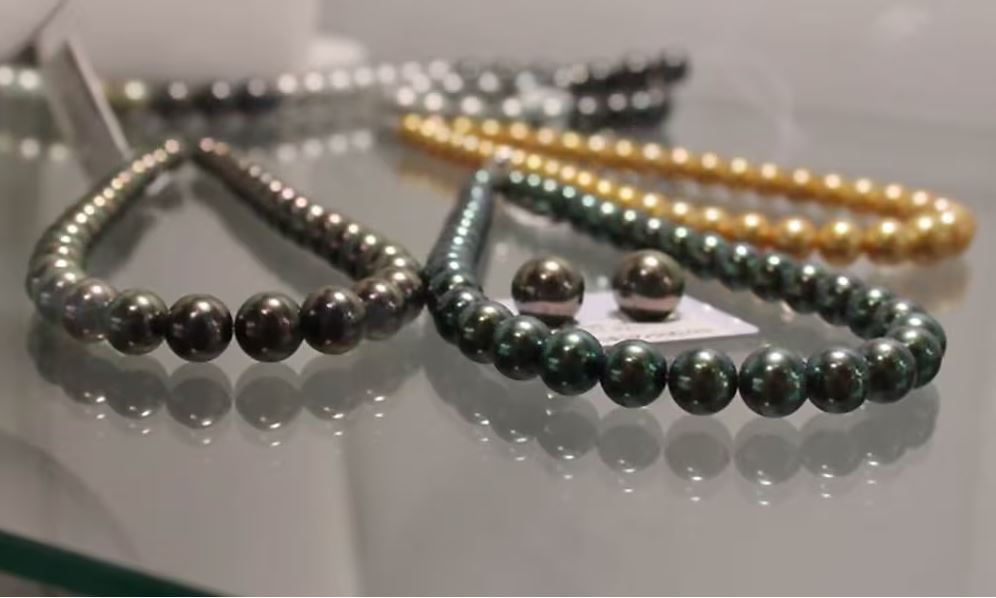
IMPORTANT FACTS ABOUT TAHITIAN PEARLS
Moderate to Large Sizes: Tahitian pearls are one of the larger pearl types out there, and generally range from 8-9mm up to 15-16mm, and sometimes, even larger.
Large Array of Shapes: Tahitian pearls offer a pearl shape for every personality, and price point. From rare perfectly round pearls to smooth drop shapes, and funky baroques dripping with character. The most sought after are the perfectly round pearls, followed by smooth drops, and then baroques of all shapes.
Rainbow of Natural Colours: Tahitian pearls are world famous for their dark body colours in shades of charcoal grey to true black. But their most famous attribute is the rainbow of overtones that excite the eye. From colourful peacock to cool shades of tropical greens, blues, eggplant, silver and gold to rose, and cherry. Tahitian pearls are guaranteed to offer something for everyone to enjoy.
Satin-Like to Mirror-Like Luster: Tahitian pearls have very thick nacre, and generally will feature softer, more satin-like luster. However, most high quality Tahitian pearls, particularly in the smaller size ranges, will display a sharper, highly reflective luster that comes closer to the “mirror-like” shine of the Japanese Akoya.
Tahitian Pearl Type: Tahitian pearls are cultured in the saltwater oyster pinctada margaritifera black-lipped oyster. The pinctada margaritifera oyster is native to the French Polynesian island chain in the South Pacific Ocean, and can be found as far away as the Philippine islands.
TAHITIAN PEARL PRICE GUIDE
Tahitian pearls are some of the rarest, most valuable, and most expensive, pearls on the planet. A single, large, top quality Tahitian pearl can cost anywhere from $150 – $2000+ USD, while Tahitian pearl jewelry often ranges from $200 USD to $20,000+ USD.
Often pearl buyers are puzzled by Tahitian pearl prices. But these prices are a transparent window into how much Tahitian pearls are really worth.
Tahitian pearls are rare, and this rarity makes them valuable, and expensive. The indisputable fact is that Tahitian pearls can only be cultured in a few, remote parts of the world. This is one reason why these pearls are rare and expensive. Next, Tahitian pearl production involves a considerable investment of time, and hence money for a pearl farmer. Cultivated in offshore saltwater pearl farms in the islands of French Polynesia, it takes a minimum of two years from birth for a Tahitian black lip pearl oyster to become mature enough to be bead nucleated, and start producing pearls. It then takes a further at least another two years for a pearl to develop.
This extended time, from the birth of the oyster up to the harvest of the pearl adds to the cost of producing each pearl.
Plus, each black lip pearl oyster can produce only one pearl at a time, which is different from Freshwater pearl mussels, that can produce up to 30 pearls per shell at harvest.
All these factors explain the rarity of these stunning black Tahitian pearls and hence their high price tag.
The truth is that Tahitian pearls are stunning, and quite unlike any other type of cultured pearl. Their colours, size and distinctive iridescence makes them a popular choice for jewelry lovers everywhere. And pearl lovers are happy to pay luxury prices for these superb pearls.
Here is a snapshot of the average price for different Tahitian pearl jewelry styles:
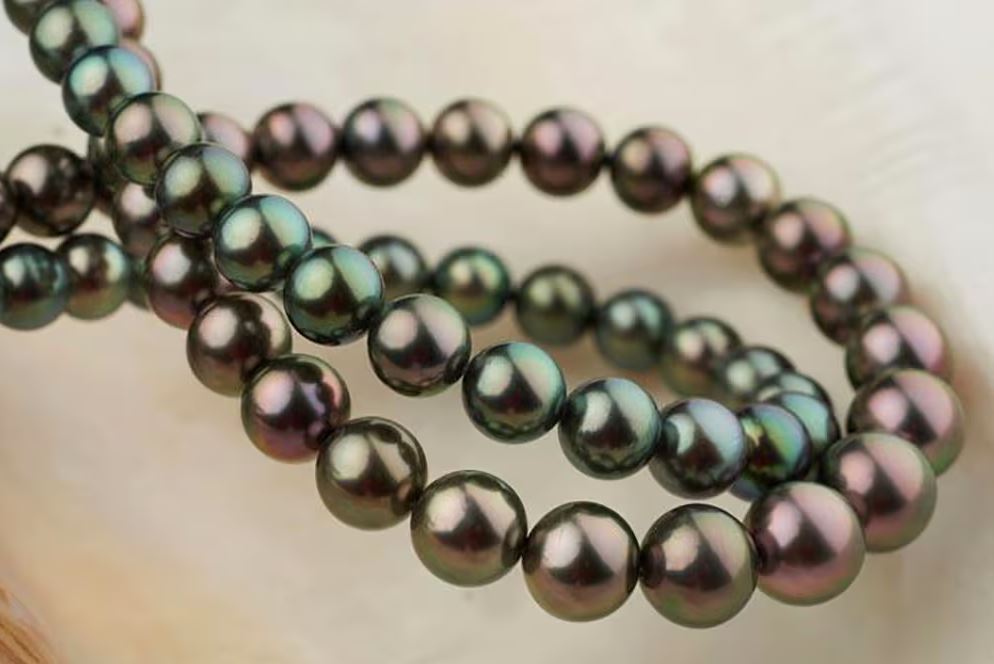
Tahitian Pearl Necklace Prices: $350 – $25,000+
Tahitian Pearl Earring Prices: $150 – $1,500+
Tahitian Pearl Pendant Prices: $300 – $3,000+
Tahitian Pearl Jewelry Set Prices: $550 – $2,000+
Tahitian Pearl Ring prices : $550 – $2,500+
WHERE DO TAHITIAN PEARLS COME FROM ?
Tahitian pearls are farmed throughout the tropical lagoons, and atolls of the French Polynesian island chain that dots the South Pacific. The pearls are not actually farmed on the island of Tahiti, but Tahiti does act as the major export hub for all Tahitian pearls.
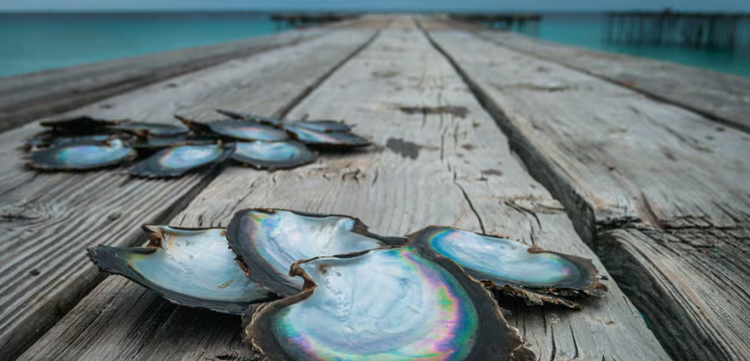
Tahitian pearls are grown within the pinctada margaritifera black-lipped saltwater oyster, which can reach the size of a dinner plate when fully grown. The black-lipped oyster is known for being particularly colourful and iridescent.
ARE TAHITIAN PEARLS CULTURED ?
Tahitian pearls are cultured pearls, and they are primarily cultivated on small, family owned farms and collectives located throughout the picturesque islands of French Polynesia.
ARE TAHITIAN PEARLS FRESHWATER OR SALTWATER ?
Tahitian pearls are saltwater pearls that are cultured on pearl farms located in the protected lagoons, and atolls of French Polynesian coastal waters. These sheltered locations ensure, that the oysters, and their pearls grow in warm, safe and pristine waters.
The oysters are hung from long-lines and allowed to gently drift in the waters to filter feed while the pearls inside them accumulate thicker layers of nacre.
What happens after Tahitian pearls are harvested ?
The pearls are harvested after a period of 18-24 months, and are only scrubbed clean, and polished afterwards.
For the vast majority of Tahitian pearls, the colours you see are totally natural, and organically beautiful.
The harvested pearls are then sent to Tahiti to be x-rayed to ensure that their nacre depth is thick enough to qualify for export (0.8m minimum thickness).The pearls are then generally sent to Hong Kong, or, Japan where they are sold at major gem shows, and auctions.
Tahitian Pearl Grading.
At our store, we grade all Tahitian pearls on the A – AAAA Grading System, which easily converts from the A – D grading scales, that Tahitian farmers use to evaluate their pearls. “A” represents the lowest commercially available grades, and “AAAA” represents the very best of each harvest. While on wholesale grading has “A”, as the top grade, and, “D”, as the lowest.
“GEM” quality Tahitian pearls are pulled from “AAAA” quality harvests as being the finest of the class. Gem quality Tahitian pearls are rare, and expensive.
The “7 Value Factors” are used by jewellers, and pearl specialists to gauge pearl quality, and then price them out. With Tahitian pearls, five factors are used to determine a pearl’s ranking on the A – AAAA Grading Scale. Colour is added, “shape” is dropped because any shape can still be graded as “AAAA” as long as the other value factors are there.
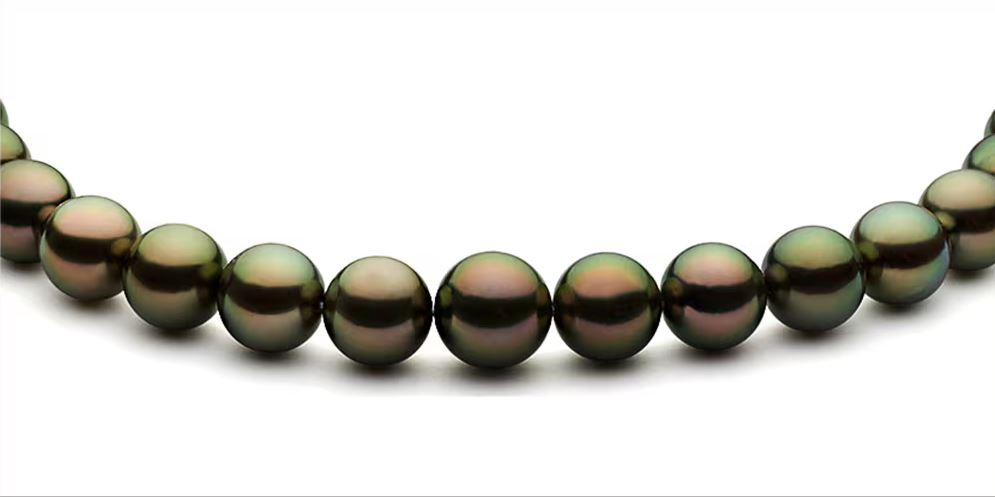
TAHITIAN PEARL GRADING FACTORS
Surface Quality.
Luster.
Colour.
Matching.
Nacre Thickness.
Surface Quality: 95-99% Clean to the Eye. Necklace will appear clean to the eye upon casual inspection. Close inspection will reveal shallow inclusions less than 5% of total strand.
Luster: Excellent/Very Sharp. Detailed Reflections Visible in Surfaces
Colour: Vivid, Saturated and Intense Overtones.
Matching: Near-Perfect to Perfect for Size, Shape, Body Colour, Overtone, Surface Quality and Luster
Nacre Thickness: 0.8mm Minimum/Very Thick .
Tahitian pearls range from moderate to large pearl sizes and are considered one of the largest pearls. Averages range from 8mm, up through 16mm and even larger.
The most common and popular size range is around 9-12mm. Anything larger, and you’ll see dramatic increases in price – but these can be absolutely stunning if they’re within your budget.
TAHITIAN PEARL SHAPES
The variety of pearl shapes that Tahitian pearls are available in can be astounding to jewelry shoppers not familiar with the more exotic pearl types. Perfectly round Tahitian pearls are the most rare, and account for a tiny fraction of each year’s harvests, with symmetrical drops, buttons, baroques, circles and more making up the majority of the pearls recovered each year.
Tahitian pearl shapes can be broken down into the following categories:
Round
Semi-Round
Drop
Baroque
Circle
Free-From Baroque

TAHITIAN PEARL COLORS
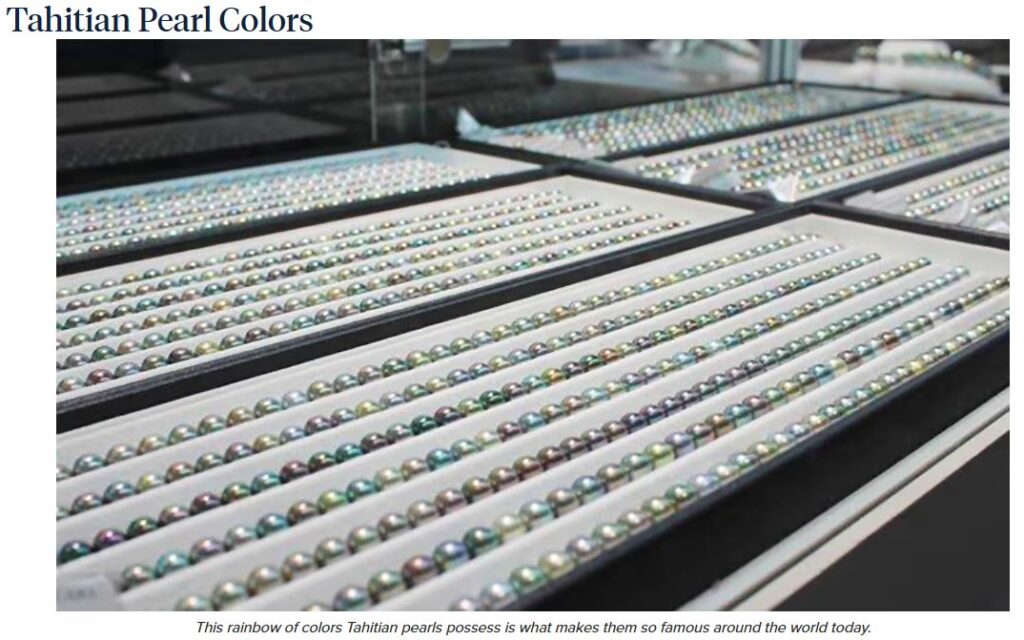
This rainbow of colours Tahitian pearls possess is what makes them so famous around the world today.
Tahitian pearls are probably the most colourful pearls in the world today. The endless variety that is presented to pearl shoppers is one of the most attractive and well-known attributes of Tahitian pearls.
TAHITIAN PEARL BODY COLOR
Tahitian pearls can come in black, grey, green, blue, purple, and peacock varieties. But their natural colours have more complexity than what appears at first sight. Tahitian, which are also called “black pearls” aren’t really black, but show up most often in a large range of dark grey body colours, tinged with colourful overtones, that can be soft and shimmering, or intense. and vivid. The important thing to note here is that these colours are all natural, and not treated, or enhanced in any way.
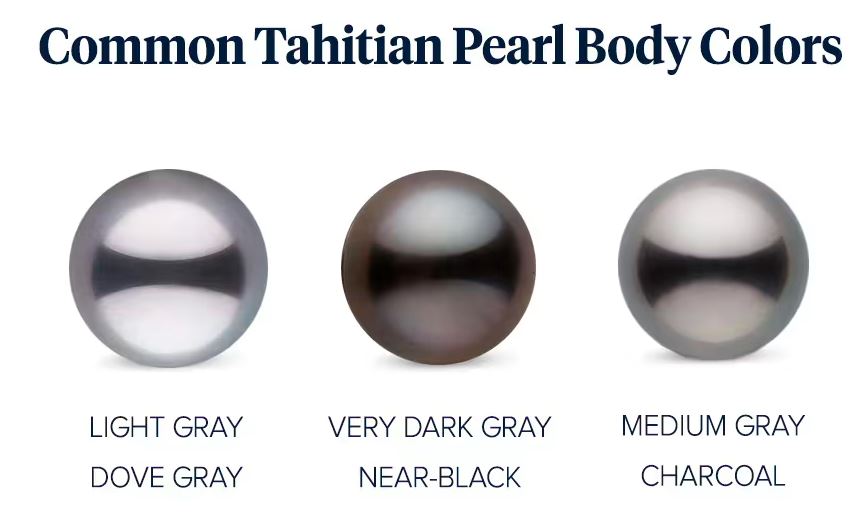
TAHITIAN PEARL OVERTONE COLORS
Tahitian pearls are famous for their colourful overtones, that’s what makes these pearls so unique and so sought after. Because, Tahitian pearls cover a range of body colour, and overtone combinations, the variety of colour you can see is nearly endless. No two pearls are exactly alike.

Green to blue-green overtones are some of the most common Tahitian pearl overtones you’ll come across today. These pearls feature a cool green to blue-green overtones over dark charcoal grey body colours. Tints of other colours are also present.
The most famous Tahitian overtones are:
Peacock: “Peacock” is the most famous of all Tahitian pearl overtones. It shows up as a mix of green, rose and gold colours. the Peacock overtone has many variations depending on how warm or cool the green colours are, and how much rose, or gold is present.
Green to Blue-Green: Probably the most common Tahitian pearl overtone. These can also be warm or cool, dark and saturated or pale and shimmery.
Cherry and Aubergine: These pearls have distinct pink, and purple overtones that make them quite lovely.
Silver to Steel: the Silver and Steel overtones are also very common, and usually show up as a whitish patina over the base body colour. The best Silver coloured pearls feature an overtone laid over a light grey body colour, and may feature additional tints of blue-green and green. Steel overtones are very commonly seen in larger pearls.
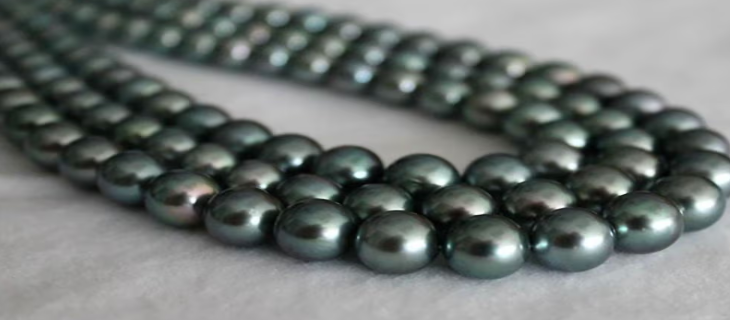
SIMPLE RULES FOR CARING FOR TAHITIAN PEARLS
Pearls on Last: make sure that your pearl jewelry is the last part of your outfit you put on. This is after all cosmetics, perfumes, hairspray, etc., and then the pearls can be added. This gives the pearls a chance to avoid being exposed to any chemicals and possibly discoloring over time.
After Care: after you’re done wearing your pearls for the day, it’s a good practice to wipe them down with a soft, slightly damp cloth. This helps remove any residues like sweat, oil or other chemicals they may have picked up from the day.
Storing Necklaces: it’s best to lay your necklaces down flat in your jewelry box rather than hang them on a hook when you’re done wearing them, as this stops the silk knotting from stretching out in between each pearl. Pearls should be stored away from other jewelry with sharp metal components to prevent surface scratches.
Restring Your Pearls: another great way to keep your pearl necklaces, and bracelets looking their best is to get them professionally restrung once a year to once every two – three years or so, depending on often you wear them. Restringing your pearls keeps the knots fresh, tight and non-frayed.
Avoid Swimming and Showers: while pearls were born in the water, modern additives like chlorine is really not ideal for pearls. In addition to possibly discoloring the pearls due to repeated, long-term exposure, the chemicals in the water also eat holes in the adhesives used to secure pearl pendants, earrings and rings to their mountings. Remove your pearl ring and set it in a safe place before washing your hands or doing the dishes as well.
Avoid Harsh Chemical Exposure: other chemicals can also harm your delicate pearls, avoid exposure to hydrogen peroxide, chemical bleaches and other dyes.
Avoid Ultrasonic Cleaners: Never clean your pearls in an ultrasonic cleaner as that can permanently damage your pearls.
Avoid Storage Deposit Boxes or Airtight Containers: Pearls require moisture in order to retain their beauty and structural integrity, so airtight environments are deadly to pearls. There have been stories of pearls left in bank deposit boxes for safekeeping, only to open the box twenty years down the line to find pearl dust.
Wear Your Pearls: Like we said, pearls love moisture, and will benefit from absorbing the oils in your skin, which will help moisturize the nacre layers and aragonite (think organic glue), holding the layers together, keeping everything nice, and lustrous.
Add Your Heading Text Here
Tahitian pearl jewelry offers something for everyone to admire. From classic strand necklaces to longer baroque pearl ropes, dazzling pearl and diamond earrings, pendants and stunning matched Tahitian pearl sets, offers an extensive collection of black pearl jewelry at a range of price points from affordable to luxury.
Tahitian pearl necklaces can be both round and baroque, and generally measure out to 18” fully knotted (longer lengths can be made to order!). Each strand is double-knotted on black silk, and finished with a 14K gold clasp of your
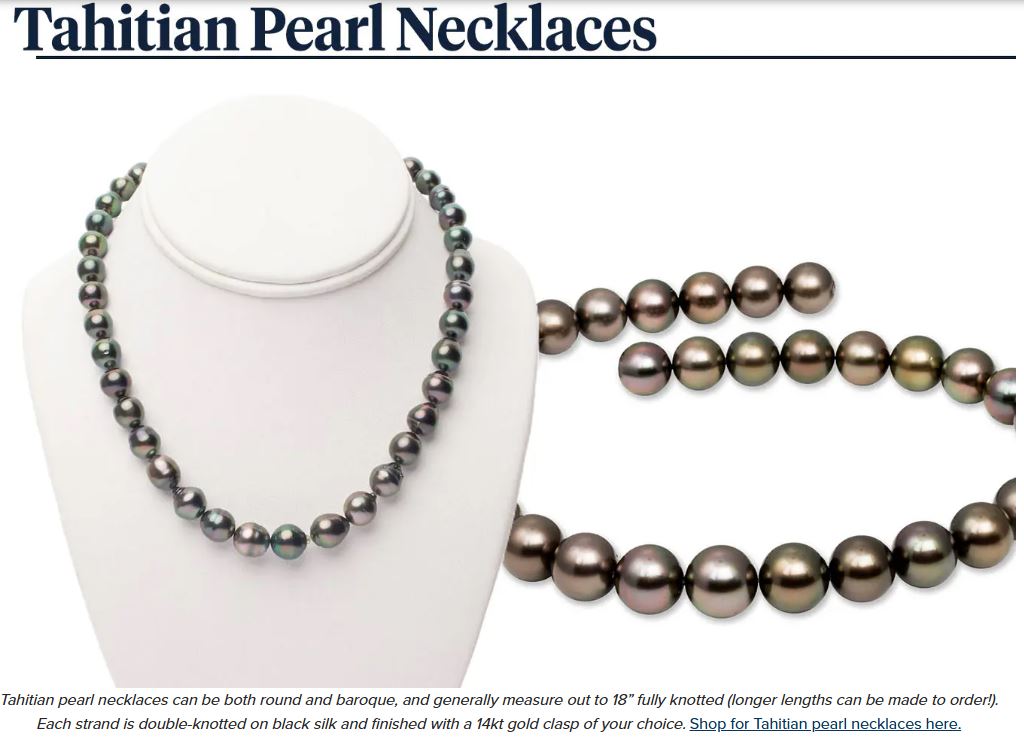
TAHITIAN PEARL MEANINGS
Tahitian black pearls, with their mysterious aura and unique charm symbolize protection, wealth, beauty and strength. But their most enduring meaning is hope.
There are also many legends and myths that surround the exotic and alluring Tahitian pearl.
According to one French Polynesian legend, Oro, the God of War as well as of Fertility and Peace, offered a black pearl to the princess of Bora Bora as a token of his love. In another French Polynesian legend, Oro gave two mythical pearls to his princess – an exceptionally beautiful peacock Tahitian pearl and a sculpted, circle Tahitian pearl.
In another legend, the Moon bathes in the ocean, attracting oysters to its light. As these oysters come to the surface, the Moon bestows heavenly dew upon these oysters which in time become Tahitian pearls with blue, green, gold, and cherry overtones.
In Chinese mythology, a black pearl was formed in the head of a dragon, thus symbolizing wisdom, and intelligence.
The ancient Greeks and Romans, by contrast, believed that black pearls were formed where a rainbow met the earth.
SO, WHY BUY TAHITIAN PEARLS ?
Cultured Tahitian pearls are one of the most attractive and enchanting cultured pearls. With their dark and shimmering body colors, fabulously colorful overtones and striking iridescence, they have captured the hearts of countless jewelry lovers since they first debuted in the jewelry world. Elegant and sophisticated, the Tahitian pearl jewelry at Pearls of Joy is a must-have for every jewelry collection.
